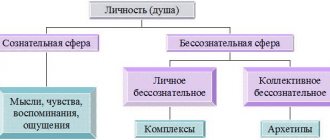What is psychoanalysis?
Psychoanalysis emerged as a way to treat neuroses and later became a theory of psychology. Let's look at what psychoanalysis is in psychology. A person is designed in such a way that he cannot understand everything that happens in his inner world.
Psychoanalysis is a special type of therapy in which the patient is able to remember the events he experienced and analyze the unconscious desires and motives that form his internal psychological conflicts, determine his behavior and way of thinking.
Psychoanalysis helps:
- find reasons and improve relationships with others;
- solve the problem of psychological dependence;
- survive crises in the family and difficult situations at work; let go of grudges;
- understand your purpose in life;
- understand the reasons and get rid of the feeling of loneliness;
- enjoy the relationship, etc.
In the modern world, “having your own psychoanalyst” is almost becoming the norm. Do you want something and you can't get it? Do you want to create a stable relationship, but all attempts end in failure? Don't you feel inner comfort? Do you have obsessive thoughts or fantasies that are bothering you? These and other issues, which are a conflict between the conscious and the unconscious, are resolved in psychoanalysis.
Nothing happens for nothing
Freud discovered that there are no misunderstandings or coincidences. Do you think these feelings are random and dictated by impulses? But in fact, any event, desire and action, even those committed on a subconscious level, plays an important role in our lives. A young woman accidentally left her keys in her lover's apartment. Her subconscious reveals secret desires: she would not mind returning there again. The expression “Freudian slip” arose for a reason. The scientist believed that verbal blunders and mistakes reveal true human thoughts. Very often we are driven by fears from the past, experienced traumas or hidden fantasies. No matter how we try to suppress them, they still break out.
Why dinosaurs became extinct: a new theory could be a historical breakthrough
Eat your vegetables first: a nutritionist explains how to eat pizza correctly
Invincible vaccine: that’s what the Serbian ambassador, who has already been vaccinated, called Sputnik V
Who is the founder of psychoanalysis?
The history of psychoanalysis goes back more than a hundred years. Psychoanalysis was first used to treat neuroses. The founder of classical psychoanalysis is the Austrian neurologist, psychologist and psychiatrist Sigmund Freud.
The founder of psychoanalysis, Sigmund Freud, had advanced views on human nature for his time. Freud's psychoanalysis was based on the study of unconscious aspects of personality and analysis of the early childhood of patients.
Psychoanalysis was not clearly accepted by the scientist’s contemporaries. The conservative society of that time was not immediately ready to accept the fact that people’s behavior and thoughts are controlled not by the mind, but by some unconscious mental forces. Neither philosophers nor doctors could calmly accept Freud's psychoanalysis. The theory of psychoanalysis itself was essentially somewhere in the middle and was imbued with philosophical ideas and medical concepts.
A thought is a sharp turn on the way to the fulfillment of a desire
Freud highly valued the very act of thinking (desires and fantasies). Psychotherapists and psychoanalysts often observe people's fantasies in their practice. They often value them higher than actual real-world performance. And although reality cannot be measured through vivid imagination, this phenomenon has its own unique purpose. Neuroscientists say this serves as the basis for imagination.
Sponge roll with grapes and butter cream: don't stop at 1 piece
“You need to teach from early childhood”: Komarovsky told how to sneeze correctly
The “warranty period” for the service life of the spine has been named, but it can be extended
Psychoanalysis by Sigmund Freud
Freud initially conducted psychoanalytic sessions using hypnosis to suppress traumatic associations. However, the scientist subsequently abandoned this and used the method only while the patient was awake.
Psychoanalysis was formed on the “free association technique”: a person, when communicating with a specialist, says everything that comes to mind in the process of “analyzing” his condition. It turned out that for effective psychoanalysis, the “material” that the psychoanalyst receives from what the patient says was sufficient.
Indeed, a person in ordinary life is practically deprived of the opportunity to say whatever he wants, whenever he wants. People behave insincerely with themselves, hide their desires and thoughts from themselves. This creates dissatisfaction, which leads to neuroses and depression.
People want to say what they think and share their secrets. Conventions often prevent you from doing this in a familiar environment. Partially, psychoanalysis can be attributed to a textbook conversation - an “outpouring of the soul” with a random fellow traveler on the train, who, fortunately, turned out to be a good listener.
But a random fellow traveler on a train is at most a good listener. It will get easier, but it won't solve the problem. A specialist psychoanalyst, based on the connection between conscious thoughts and unconscious content, finds explanatory hypotheses of what and why is happening in a person’s life and, together with the patient, gives an answer to the question - what to do?
There is a Turkish sofa in the Sigmund Freud House Museum in London. It was this sofa, covered with carpets, that served as the prototype of the “couch” where the famous psychoanalyst put his patients during psychoanalysis.
Couch in Sigmund Freud's officeFreud sat at the head, and the patient, lying with his eyes closed on the sofa, talked for several hours about everything that worried him. Freud asked the patient to say whatever came to mind without thinking. In psychoanalysis, the very fact that a person was listened to attentively had a therapeutic effect. It turned out to be a kind of “talk therapy.”
Let's look at Freud's psychoanalysis briefly and clearly.
Before Freud, the position was accepted that the human psyche (soul) is holistic. Then the concept of “unconscious” appeared. According to Freud's theory, the human psyche is conventionally divided into conscious and unconscious. The unconscious is attitudes, desires, attractions. A person’s internal “censor” - a special mechanism of the psyche - does not allow the unconscious to break out in a direct way. Unconscious symptoms accumulate, find their way out and manifest themselves.
During psychoanalysis, a person “pulls out” the unconscious from himself, remembers and tells everything that has accumulated. After what has been said, the patient experiences relief and even healing from the consequences of certain events, desires, and inclinations.
Freud believed that the nature of the unconscious depends on the events experienced and on why a person suffers and cannot admit it - envy, feelings of inferiority or superiority, aggression and the like. In Freud's theory of classical psychoanalysis, the experiences of the first five years of life are decisive for a person. The unconscious originates in the emotions of childhood and affects the rest of life.
Freud said that during psychoanalysis a person relives many events, including those from childhood. Often the client’s attitude towards the psychoanalyst during a session becomes similar to his attitude towards his own father or mother with a whole range of feelings.
Psychoanalysis according to Freud is actually the “pouring out” or transference to the therapist of feelings and drives that make up the unconscious.
Such sessions should be frequent and last until the person completely gets rid of neurotic symptoms, complexes and various obsessive thoughts. On average, psychoanalysis is carried out in sessions of several months, 2–4 times a week.
It is noteworthy that Sigmund Freud himself said that psychoanalysis in its pure form is unlikely to make a person happy, it will only help him feel less unhappy.
S. Freud's methods of psychoanalysis, used in the treatment of psychological problems, led to a more detailed understanding of the influence of unconscious desires on human psychology. Psychoanalysis has made it possible to better understand the nature of psychosomatic illnesses.
Sigmund Freud's theory of psychoanalysis is not a “fossilized” quantity, it is developing. During his lifetime, the scientist awarded an annual prize for the achievements of his students in the development of the theory of psychoanalysis.
They say about Sigmund Freud that he saw everything “through the glasses of sexuality.” Freud saw the basis of all unconsciousness in the theory of libido and childhood sexuality. His followers were often criticized for this approach. The famous psychologist Carl Jung saw the nature of the unconscious in the collective memory of humanity.
Basics of psychoanalysis
In the theory of psychoanalysis, the subject of study is the influence of unconscious motives on human behavior and thoughts. The psychoanalytic approach in psychology is to help the patient find and understand those thoughts, attitudes and fantasies that control his life. The method of psychoanalysis makes it possible to see how a person perceives life, how his thinking works, how unconscious desires relate to real possibilities.
As an example, in psychoanalysis it becomes clear that the difficulty of establishing relationships and creating social contacts may be associated with a certain imbalance. On the one hand, a person has a need for relationships. On the other hand, he has increased vulnerability, fear of being rejected and even contempt for other people.
Freud called psychoanalysis a specific therapy, during which the client says everything that comes to mind: his thoughts, fantasies, and dreams. The psychoanalyst often comes to the attention of the patient’s dreams. Sometimes hidden, unconscious motives for certain actions appear in dreams. In this case, the interpretation of dreams helps solve a person’s psychological problems. Sigmund Freud called dreams “the royal road to the unconscious.” When a person is awake, his consciousness limits the forces of the unconscious; during sleep, the containment of these restraining forces is limited.
Based on the information received, the psychotherapist makes a conclusion about the nature of the unconscious, the causes of conflicts and problems in the patient and suggests ways to resolve them.
The fundamentals of psychoanalysis can be distinguished by the following theses:
- Human behavior is largely determined by irrational unconscious experiences.
- Human behavior is determined by conscious and unconscious forces. In psychology, the unconscious refers to phenomena and processes that are not controlled by human consciousness. In the sphere of the unconscious there are fantasies and desires that are incompatible with the basic norms of behavior and morality. Unconscious thoughts include thoughts that disturb us, but which we are not aware of. Unconscious experiences complicate life and lead to mental and nervous disorders, depression, and fears.
- If a person tries to become aware of unconscious thoughts and experiences, then defensive resistance arises.
Freud called this resistance “the force that maintains the painful state.” To get rid of the problem and recover, you need to destroy the created resistance through working through it.
The psychoanalysis procedure is based on the fact that the client is in a relaxed state and says whatever comes to his mind, no matter how absurd or even obscene it may seem. Patients need to abandon any “filtering” of thoughts; all ridiculous, awkward or off-topic thoughts during the procedure should be voiced. This is a kind of projection of unconscious material in a special, symbolic form. Such study allows us to understand internal conflicts, increase the energy and adaptability of the individual.
With professional help, through awareness, liberation from the influence of the unconscious is achieved.
The main directions of psychoanalysis are related to not only eliminating the symptom, but understanding the nature and causes of the conflict that lead to psychological discomfort. The result of the specialist’s effective work is the disappearance of disturbing symptoms and the absence of relapses for them.
Defense Mechanisms
Now we take the term “defense mechanism” for granted. This has long been part of the basic understanding of human behavior. The theory, which Freud developed with his daughter Anna, states that in order to protect against feelings of anxiety or unacceptable impulses, the subconscious mind can deny or distort reality. There are many types of defense mechanisms, the most well known being denial, denial and projection. Denial is when a person refuses to acknowledge what has happened or is happening. Refusal is formed due to reluctance to admit one’s addictions (for example, alcoholism or drug addiction). This type of defense mechanism can also be projected into the social sphere (for example, reluctance to acknowledge the trend of climate change or victims of political repression).
Taurus are very practical: the zodiac signs that think through everything down to the smallest detail
Unexpected life: unknown animals found under the ice of Antarctica
Good luck if the traffic light is green: these and other modern superstitions and signs
Where is psychoanalysis used?
According to the definition, psychoanalysis is a process in which a person’s understanding of himself and his “I” passes through the awareness and elaboration of internal conflicts. Psychoanalysis works with the “unconscious” - desires, motives, conflicts, drives, impulses. Behaviors, actions, reactions and the whole life of a person are largely connected with the unconscious. It is believed that psychoanalysis affects up to ninety percent of mental processes.
Psychoanalysis and psychotherapy are closely related. Psychoanalytic methods are often used to resolve conflicts in relationships, to overcome stress and crisis situations.
Psychoanalysis works successfully with different groups of people. Psychoanalysts say that patients often say the same phrase at the first session: “I understand everything, but I don’t know what to do. Nobody can help me."
Among those who undergo psychoanalysis, the majority are women. This can be associated with their greater immaturity and vulnerability of the female psyche.
For example, psychoanalysis helps to find reasons and ways of self-realization for the wives of wealthy people. Housewives are frequent visitors to the psychoanalyst's office. Their main complaint is “life is wasted.”
Another typical type is also a woman, but different. She is an active “businesswoman”; in life she has to compete fiercely with men. Often, the psycho-emotional state of a “man in a skirt” can destroy not only her own psyche, but also significantly worsen the comfort of those around her. Experts say that this type of woman mentally “castrates” the men around her and makes children overly infantile. The main problem of a woman who bears everything on herself is her lost female identity.
The male psyche is structured in such a way that many men consider going to a psychoanalyst to be a weakness. It can be difficult for men to decide on their own to make an appointment. Statistics show that most men are brought to appointments by women. And yet, among the patients of psychoanalysts, only a third are representatives of the stronger half. Their age ranges from 30 to 50 years. A third of men's problems are related to problems in the family and relationships. At the same time, among the children at the reception, boys predominate, and their mothers also bring them.
At the same time, statistics show that men who do not seek help often become victims of internal conflicts; uncorrected experiences in time develop into significant problems in the future.
Experts call “psychological masochism” when a person is in a constant state of crisis tension and living on the brink of survival, and at the same time is unwilling to seek help and, together with a specialist, find the root of his problems.
In modern society, it is difficult to maintain mental health. Most often people come to psychoanalysts with anxiety disorders, obsessive thoughts, and depression. However, even among relatively healthy and successful people, a certain demand has arisen. Not all successful people can enjoy their achievements and successes. A person “has everything,” he “has achieved everything,” but there is no happiness. And many find it difficult to admit this.
What is the essence of psychoanalysis?
Psychoanalysis is a process similar to a psychological ritual. The process of psychoanalysis can last from twenty to thirty minutes to several hours. The therapist and patient rarely sit opposite each other. As a rule, the client is placed on a couch, and the specialist is nearby, but the patient does not see him.
There is no physical contact between them. There are no taboo topics for the patient; he voices everything that comes to his mind. The patient is relaxed. Such an atmosphere should lead to a deep immersion in the experienced events, which are the basis of the internal conflict.
The key idea of psychoanalysis is that in the process a certain picture of personality is created. Psychoanalysis is sometimes called “a way to heal the soul.” The goal of psychoanalysis is for a person not only to “pull out of himself” and talk about the events he experienced. It is important that the patient in the process has the opportunity to think, experience and express his own attitude to events. During psychoanalysis, the patient makes joint conclusions and makes joint decisions with the specialist. Thus, the patient learns to independently analyze his condition, build hypotheses and draw conclusions.
Psychoanalysis can become a source of self-knowledge for a person. The information shared by the client is interpreted by the specialist. This allows you to look at situations in a new way.
In psychoanalysis, not only professional training is extremely important, but also the personality of the psychoanalyst himself. An experienced analyst establishes a trusting and unobtrusive relationship with the patient. Sometimes you can hear that a psychoanalyst is at the same time a teacher, educator and spiritual father.
The psychoanalyst focuses attention not only on the problems voiced and helps resolve the conflict between the unconscious and consciousness. An experienced specialist tries to understand the person’s personality as a whole and help him accept and understand himself in the future.
Modern psychoanalysis is a deep direction in psychology that studies changes in personality functioning. Mental disorders have not only physical causes (damage to the brain and nerve cells). Psychoanalysis allows us to identify unconscious forces, analyze the content of thoughts and weaken their influence on a person’s psychological state.
Recently, the so-called psychoanalytic therapy, that is, psychoanalysis in the light version, has become popular. Its focus is to help a person improve their quality of life and enjoy every day.
Can psychoanalysis cause harm?
From its inception to the present day, the theory of psychoanalysis has been constantly criticized. Despite criticism, psychotherapists and psychologists still practice psychoanalysis.
Not everyone in the scientific community supports Freud's theory of psychoanalysis and calls his works "intellectual quackery" and even "fraud."
Russian and American writer Vladimir Nabokov openly criticized the theory of psychoanalysis and did not hide his hostility towards Freud. However, Nabokov's critics and friends argued that "Freud's shadow followed the writer all his life." In this sense, Vladimir Nabokov’s novel “Lolita” is indicative, where an adult man is attracted to a young girl. The source of this passion lies in the protagonist’s unrealized childhood love for a girl his own age. The novel “Lolita” is considered one of the outstanding works of the 20th century, although at first it was called a “dirty little book” or “pornography”, and they wrote about the author that his “moral feelings have atrophied”.
Official statistics show that the popularity and relevance of psychoanalysis is declining these days. However, unofficial sources say that psychoanalysis still has an influence on psychiatry. With effective psychoanalysis, a person can restore his psychological health and balance, get rid of melancholy, depression, anxiety and regain the meaning of life.
I will debunk the myth that psychoanalysis allows the psychoanalyst to make some kind of “diagnosis” for the patient. The diagnosis can only be made by a psychiatrist. Sigmund Freud said about psychoanalysis that it is a “talking cure.”
Another “horror story” why psychoanalysis is criticized concerns fears that this method is exclusively about talking about sex. Not at all. You talk about everything that is in your head. The specialist cares about what you say and why.
Discussion of such a phenomenon as psychoanalysis, harm or benefit to people from this method, must begin with the readiness of the person himself for the process.
For psychoanalysis, the analyzability or readiness of the client (patient) is important. Analytical ability implies a person’s developed ability for introspection and introspection, as well as a sufficient “bar” of intelligence. Psychoanalysis is significantly limited if a person does not want to change himself, and in a conversation with a psychoanalyst insists that his environment must change.
Psychoanalysis is a complex and lengthy work. If a person is determined to achieve results too quickly, this can limit the effectiveness of the process.
Psychoanalysis differs in that it does not use drug therapy, and the result largely depends on the efforts of the patient. Psychoanalysis is a complex and lengthy work. If a person is determined to achieve results too quickly, this can limit the effectiveness of the process.
Experts say that a person is ready for psychoanalysis if he:
- Has a desire to understand himself, his thoughts and actions.
- Wants to better adapt to the realities of the modern world.
- Ready to change and adjust your thoughts and actions.
Sometimes the human psyche literally begins to “resist” the need to dig up something that seems long forgotten. But without such “digging” it is simply impossible to solve existing problems and move on calmly. Many people have problems and at the same time do not want to upset the established balance in life, even if this balance is associated with neuroses and depression. Professionals in the field of psychoanalysis consider the recognition and interpretation of the patient's resistance to be the main task of psychoanalytic technique.
The weakness and strength of every person is his sexuality
Sex is the main driving force for people. This is exactly the denominator under which we can fit all of us. However, many people deny this at all costs. We are so imbued with the lofty principles of Darwinism that we are ashamed of our animal nature. And, despite the fact that we have risen above all other living beings, we still have their weaknesses. For most of its history, humanity has denied its “dark side.” This is how Puritanism was born. But even the most correct people are forced to fight against their own sexual appetites throughout their lives. Take a look at the many scandals that have rocked the Vatican, other fundamentalist churches, prominent politicians and celebrities. Early in his professional career, Freud observed this lustful struggle among men and women in Victorian Vienna, from which he drew his conclusions.







